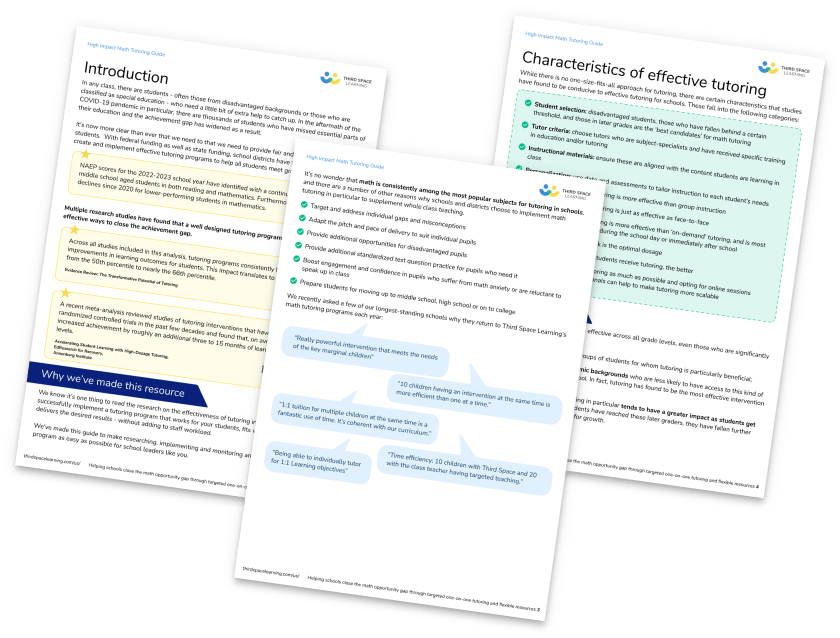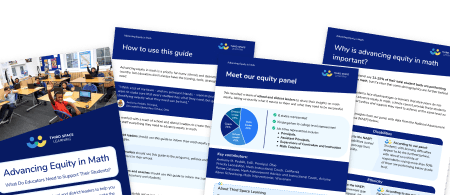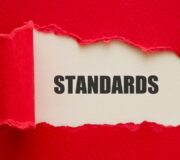Equity in Education: A Guide To Supporting Your Disadvantaged Students
Equity in education is rooted in the belief that all students deserve access to resources, opportunities and support within the education system. It is the role of school and district leaders and educators to promote equity.
However, the 2024 NAEP scores show that equity is still a complex issue. Educational equity requires an understanding of systematic barriers, such as socioeconomic status, that reduce access to resources and lead to poor outcomes for some learners.
This article explores how continued efforts and strategic approaches within districts, schools and individual classrooms can lead to greater educational equity.
What is equity in education?
According to the National Equity Project, Equity in education means “each child receives what they need to develop to their full academic and social potential.” Similarly, the NCTM describes educational equity as providing reasonable and appropriate accommodations as needed to promote attainment for all students.
Equity in an educational environment is the principle that all students, regardless of their background or circumstances, receive the opportunity to succeed and reach their academic goals within the education system. As such, it creates a level playing field for all learners.
A lack of educational equity originates from a complex series of economic, political social or cultural factors that hinder access, opportunities and outcomes. As such, schools and educational systems should be promoting equity for these groups in particular to raise their academic achievement.
Often, equity is confused with equality. These ideas differ and educators need to understand the difference.
Advancing Equity In Math: What Do Educators Need?
Identify the support and training your staff need to make the most difference when advancing equity in math. Includes insights from an experienced panel of school and district leaders.
Download Free Now!Equity vs equality in education
Equity and equality are often used interchangeably. However, equity and equality are two different concepts and those working within educational systems should know the difference.
Here’s what each concept is and how it may look inside your school environment.
Equity
What is it? Educational equity aims to create an inclusive learning environment. Equity recognizes that students have diverse backgrounds and may not start their education from the same place. They may require a different amount of support, resources and learning materials to achieve equal outcomes.
Examples: Educational equity might look like additional funding for low-income school districts, or targeted interventions for students with learning disabilities.
Equality
What is it? Equality in education refers to the idea of treating all learners the same by providing them equal opportunities, resources and support.
Examples: Equality could be when all students receive the same math textbook in their class and the same amount of instruction time, regardless of additional needs.
While having equity and equality in a learning environment is important, equity expands beyond equality. It provides the tools and resources that help all students to succeed in their learning and address underlying inconsistencies and individual needs.
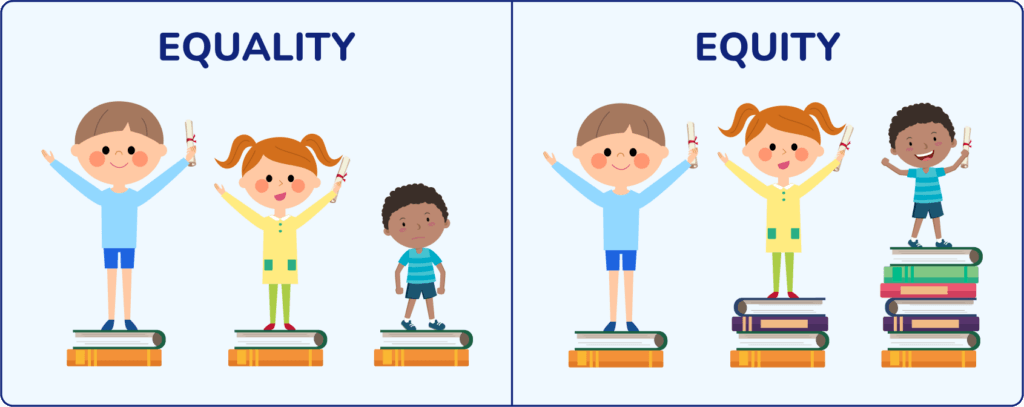
Equity and the academic achievement gap
The academic achievement gap, largely attributed to inequity, is the disparities in student performance or educational attainment between different groups. These groups can be categorized by a student’s background, including:
- Race
- Ethnicity
- Socioeconomic status
- Gender
- Other demographic characteristics
Achievement gaps are most often found in standardized test scores such as state assessments or NAEP testing, high school graduation rates, enrollment in advanced placement (AP) courses and college acceptance rates.
One equity panel found that between 11 and 25% of their student body was performing below grade level in math. Often, these learners face disadvantages or barriers to learning that their peers do not.
The latest Nation’s Report Card for 2024 highlights a continued achievement gap for lower-performing learners. This is especially true for learners whom:
- English is a second language
- Are from a lower socioeconomic status
- Have a disability
NAEP math scores decreased from 2022 to 2024 for lower-performing 8th graders at the 10th and 25th percentiles by 5 and 3 points, respectively.

Meet Skye, the voice-based AI tutor making math success possible for every student.
Built by teachers and math experts, Skye uses the same pedagogy, curriculum and lesson structure as our traditional tutoring.
But, with more flexibility and a low cost, schools can scale online math tutoring to support every student who needs it.
Find out moreChallenges implementing equity in education
Often, there are barriers to equity. The best way to overcome these and start removing barriers is to understand where they orginate and the strategies that can help reduce them.
While some barriers are to equity are more difficult to address, such as budgets, there are others within control of educators and decision-makers.
Teachers and leaders must identify theses barriers learners in their school and district face. These may include:
- English Language Learners (ELLs)
- Living in poverty
- Experiencing neglect
- Being subjected to stereotypes or biases
- Experiencing a disability
“53% of my students are learning English as a second language. We have 29 different countries represented and 19 different languages within the building.”
Anthony Peddle, Principal, Devonshire Elementary School, Ohio
While educators can’t solve these vulnerabilities solely within the classroom, they can take action to ensure that they meet students’ needs.
“Our dual language learners have language objectives, content objectives and processing objectives.”
Priscilla Leondidion, Instructional Coach, California
Benefits of equity in education
Despite the challenges, it’s crucial to ensure teachers use an equitable approach to all students. There are many reasons why school leaders and teachers alike should try to achieve equity and inclusion.
Here are a few of the benefits of promoting equity:
1. Prepares students for the wider world
When students have equitable educational opportunities, they gain lifelong skills. The knowledge, experiences and critical thinking skills they gain prepare them for the ‘real world’.
2. Improves learning outcomes
Equity differentiates the educational experience for learners. It aims to provide targeted support for struggling students. It also promotes a fair distribution of educational resources and support services, not just the same opportunities for everyone. This means disadvantaged students have access to the tools and resources needed to succeed.
Schools can apply to receive grants and funds specifically for disadvantaged learners to help create and equitable learning environment and close the academic achievement gap.
Many schools choose to use their funding for tutoring with companies such as Third Space Learning who provide math tutoring for struggling students.
An independent study found that disadvantaged students receiving math tutoring from Third Space Learning made 7 months’ worth of progress in just 14 sessions.
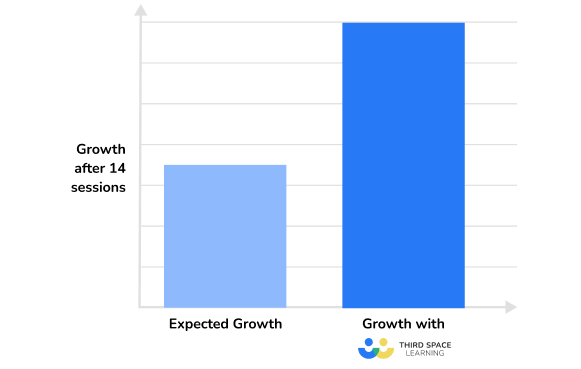
3. Increases student engagement in lessons and promotes a love of learning
Schools that create an inclusive environment where students feel valued, seen, heard and respected tend to have increased student engagement and students who develop a love of learning.
When students are able to voice their interests, concerns and needs, teachers can tailor instruction to meet individual needs and interests, making learning engaging and meaningful.
4. Reduces bias later on in life
Students who are exposed to diverse perspectives and cultures can develop tolerance, respect and empathy for others.
Equitable education addresses systematic barriers, which then empowers students to challenge bias in society.
Building equity in schools at the district level
Equity is a multi-level responsibility. For true educational equity, everyone within the education system must contribute to creating an equitable learning environment.
1. Resource allocation
School districts and administration must make decisions about how to use available resources such as school funding, staff and time to achieve a positive outcome for students. Learn more about traditional vs AI tutoring and how Third Space Learning is helping the benefits of tutoring reach more students.
2. Provide high-quality education
A high-quality education includes instruction that not only challenges students to perform at grade level standards but also focuses on the social-emotional learning of students.
Education must be standards-based and focus on what each child needs. This can also include any Response to Intervention that a child may need to fill gaps in understanding.
Districts must ensure schools and teachers are equipped with sufficient professional development training to provide an excellent education for all learners.
3. Extra academic support
Where possible, the district should ensure its schools have the funding to provide tutoring for learners ensuring equally high outcomes for all. Many tutoring strategies provide extra support to close the achievement gap.
A few other examples of extra learning support include:
- After-school programs
- Peer tutoring
- Math tutoring
- Special education services
- Academic intervention programs
- High-dosage tutoring
Online tutoring programs allow teachers the flexibility to build in tutoring time as part of a multi-tiered system of supports within the school day.
Third Space Learning’s online tutoring aims to close the achievement gap and provide equity in education. Each session provides standards-aligned math tutoring for disadvantaged pupils that can be personalized for each individual student.
AI math tutor Skye uses error analysis to provide ongoing formative assessment for each student to adapt and personalize learning in real-time.
Schools can choose the timing, dosage and length of the tutoring session for each student to help provide equity in education for the students who need it most.
6 strategies for achieving equity at the school level
In addition to at the district level, schools need to implement effective strategies to create a level playing field for all students. This creates a fair and inclusive classroom environment for student learning.
1. Address students’ specific needs
Not all students are at the same level academically. Some will have special education needs, learning disabilities and those who haven’t had a great learning experience since the COVID-19 pandemic.
The latest NAEP data shows that, on average, 4th and 8th graders are still behind in math achievement compared to pre-pandemic achievement.
Have a plan ready to address all these different needs to help you better prepare for all student needs.
2. Decision-making based on data
Teachers and administrators must use data points to plan for students’ different needs. The wealth of data available can drive educational equity by assisting with planning of:
- Instruction within the classroom
- On-going professional development that addresses best practices and research based math interventions
- Development of personalized learning plans for students with specific needs and challenges, including learning disabilities
3. Build a supportive learning environment
Building a classroom culture and classroom management strategies that allow students to take risks and encourages a positive environment for learning is important.
Students who feel comfortable and part of the classroom community are more likely to participate in classroom discussions which can lead to a deeper understanding of learning standards.
4. Policies to promote equity
Policies play an important role in promoting educational equity. They address systemic barriers and help allocate available resources equitably. This ensures that all students have access to quality learning opportunities.
5. Form partnerships between schools and community stakeholders
One of the most important partnerships that a school can secure is with members of the community. The phrase “It takes a village to raise a child” is used for a reason. It takes the whole community to support the needs and education of students.
Reach out to local community groups, churches and businesses to see how they can help support the needs of your students.
6. Provide equal opportunities
Providing equal opportunities for students means knowing your students and understanding their community.
- Advocate for your students’ rights and needs
- Assess your own assumptions and biases
- Differentiate instruction and assessment
- Personalize learning to student interests
Key takeaways
Educational equity means ensuring all students, regardless of their backgrounds, have fair and equal access to high-quality learning and appropriate support.
When equity in education is embraced, it creates inclusive learning environments, cultivates a more just and equitable society and prepares students for higher education and the wider world.
Equity is not a classroom setting or school hour problem. Schools need to consider policies, initiatives, and interventions involving the community. Reach out to stakeholders and see how they are willing to support the great teaching and learning happening on campus.
FAQs
Equity in education means providing all students with the support and resources they need to have a fair opportunity to be successful in their education journey. It takes the students as they are, takes into consideration any outside factors that may factor into their success, and provides whatever it takes to allow students to perform at their highest level.
An example of equity in the classroom would be providing additional academic support, such as additional math tools or graphic organizers, for a student who needs them. It can also be an Individualized Education Plan (IEP) for special education students.
The equity theory of education is a psychological and sociological framework that examines how fairness and justice can affect students’ attitudes, behaviors, and academic outcomes within the education system. This theory examines how students’ perceptions of fairness and equity influence their attitudes towards learning, relationships with peers and school staff, and overall experience when it comes to school.
Do you have students who need extra support in math?
Skye—our AI math tutor built by experienced teachers—provides students with personalized one-on-one, spoken instruction that helps them master concepts, close skill gaps, and gain confidence.
Since 2013, we’ve delivered over 2 million hours of math lessons to more than 170,000 students, guiding them toward higher math achievement.
Discover how our AI math tutoring can boost student success, or see how our math programs can support your school’s goals:
– 3rd grade tutoring
– 4th grade tutoring
– 5th grade tutoring
– 6th grade tutoring
– 7th grade tutoring
– 8th grade tutoring
